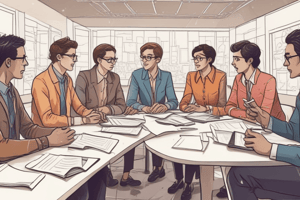Podcast
Questions and Answers
What is a key characteristic of high-performing teams as described in the performing stage?
What is a key characteristic of high-performing teams as described in the performing stage?
- Team members act independently.
- Team members prefer individual tasks.
- Team members avoid collaboration.
- Team members act interpedently. (correct)
What does the Apollo Syndrome refer to in team dynamics?
What does the Apollo Syndrome refer to in team dynamics?
- Teams create a clear decision-making process.
- Teams that thrive on conflicting ideas.
- Highly capable members work collaboratively without conflict.
- Intelligent individuals may perform poorly due to indecision. (correct)
Which behavior is typical for teams suffering from Apollo Syndrome?
Which behavior is typical for teams suffering from Apollo Syndrome?
- Efficiently resolving conflicts through collaboration.
- Engaging in excessive time spent in abortive debate. (correct)
- Focusing on group consensus quickly.
- Reaching decisions with clarity and coherence.
What tends to be a difficulty for Apollo teams during decision-making?
What tends to be a difficulty for Apollo teams during decision-making?
What is one of the weaknesses of a team member characterized as a 'Plant'?
What is one of the weaknesses of a team member characterized as a 'Plant'?
Which of the following behaviors might indicate a team is struggling with decision-making?
Which of the following behaviors might indicate a team is struggling with decision-making?
How do Apollo teams typically engage with differing opinions?
How do Apollo teams typically engage with differing opinions?
What can occur as a result of the behaviors exhibited in Apollo Syndrome?
What can occur as a result of the behaviors exhibited in Apollo Syndrome?
What is classified as relationship conflict?
What is classified as relationship conflict?
In what scenario can conflict be considered useful?
In what scenario can conflict be considered useful?
According to research, how does disagreement in teams affect decision-making?
According to research, how does disagreement in teams affect decision-making?
What is the primary characteristic of task conflict?
What is the primary characteristic of task conflict?
What can a Devil’s Advocate do in a team setting?
What can a Devil’s Advocate do in a team setting?
Which of the following is NOT a condition under which conflict is beneficial?
Which of the following is NOT a condition under which conflict is beneficial?
What is one effect of constructive conflict on groupthink?
What is one effect of constructive conflict on groupthink?
Which statement accurately reflects the view of Mary Parker Follett on conflict?
Which statement accurately reflects the view of Mary Parker Follett on conflict?
What happens during role underload?
What happens during role underload?
How are group norms primarily established?
How are group norms primarily established?
What is the fundamental problem with larger teams?
What is the fundamental problem with larger teams?
Which behavior is NOT recommended to maintain team synergy?
Which behavior is NOT recommended to maintain team synergy?
What characterizes the storming stage of Tuckman’s Model?
What characterizes the storming stage of Tuckman’s Model?
Which of the following is a consequence of social loafing?
Which of the following is a consequence of social loafing?
What is a potential outcome when group members act in cliques?
What is a potential outcome when group members act in cliques?
What can be a result of role overload in a team setting?
What can be a result of role overload in a team setting?
What is a common weakness associated with the 'Coordinator' role in team dynamics?
What is a common weakness associated with the 'Coordinator' role in team dynamics?
Which role is described as having the ability to inspire others effectively?
Which role is described as having the ability to inspire others effectively?
Which statement best defines the 'Completer Finisher' role?
Which statement best defines the 'Completer Finisher' role?
What is a notable characteristic of the 'Monitor Evaluator' role?
What is a notable characteristic of the 'Monitor Evaluator' role?
Which role tends to avoid confrontation and is diplomatic in nature?
Which role tends to avoid confrontation and is diplomatic in nature?
What is a potential negative outcome of conflict in the workplace?
What is a potential negative outcome of conflict in the workplace?
Which of the following is considered a strength of the 'Implementer' role?
Which of the following is considered a strength of the 'Implementer' role?
How is the 'Shaper' role primarily characterized?
How is the 'Shaper' role primarily characterized?
What is a potential consequence of helping someone excessively?
What is a potential consequence of helping someone excessively?
Which of the following best describes the concept of the Hawthorne effect?
Which of the following best describes the concept of the Hawthorne effect?
In the context of group dynamics, what does 'social loafing' refer to?
In the context of group dynamics, what does 'social loafing' refer to?
Which factor does NOT influence conformity according to group dynamics?
Which factor does NOT influence conformity according to group dynamics?
What role does a 'blocking' individual typically play in group settings?
What role does a 'blocking' individual typically play in group settings?
Which statement about conformity is accurate?
Which statement about conformity is accurate?
What behavior is characteristic of someone in a 'distracting' role within a group?
What behavior is characteristic of someone in a 'distracting' role within a group?
In what type of culture is conformity likely to be higher?
In what type of culture is conformity likely to be higher?
Flashcards are hidden until you start studying
Study Notes
Group Norms
- Acceptable standards of behavior within a group are known as norms.
- Norms can be established through group discussion, habitual practices, critical events, and interactions/feedback.
Team Size
- Jeff Bezos famously stated, "No team should be larger than two pizzas can feed." This suggests that optimal team size should be small enough to comfortably be fed by two pizzas.
- Larger teams can lead to difficulties finding meeting times and locations, reduced member connectivity, difficulties in communication, capitalizing on individual talents, and ideation.
- Large teams are also prone to forming cliques.
Team Synergy
- Disruptive behaviors such as bullying, incivility, withdrawal, refusal to cooperate, excessive joking, using meetings for personal confession, irrelevant conversation, and attention-seeking can hinder team synergy.
Development Stages of Groups (Tuckman's Model)
- Forming Stage: Polite conversation, getting to know team members, gathering information, uncertainty about goals and team purpose, possible anxiety or excitement. The leader takes the lead in providing direction.
- Storming Stage: Intragroup conflict, heightened emotions, emergence of a leader is crucial. Differences surface, individuals may clash, and team members may challenge leadership.
- Norming Stage: Group development, conflict resolution, appreciation of team members' differences.
- Performing Stage: High performance, team members work interdependently.
Apollo Teams
- These are teams comprised of highly capable individuals who may perform poorly due to their inability to make decisions and collaborate effectively.
- Possible problems include: excessive debate, persuading others to adopt their own view, highlighting weaknesses in others' arguments, incoherent decision-making, and individual action without considering the contributions of others.
Team Roles
- Plant: Creative, imaginative, problem solver, generates ideas, explores opportunities, and clarifies goals. However, they might be preoccupied, find it difficult to communicate effectively, and lose interest after initial enthusiasm.
- Coordinator: Outgoing, communicative, matures, identifies talent, delegates effectively, clarifies goals. Potential weaknesses include over-optimism, losing interest, and being perceived as manipulative.
- Shaper: Challenging, dynamic, thrives under pressure, driven, courageous. May be prone to provocation, offend feelings, and be overly aggressive.
- Monitor Evaluator: Sober, strategic, discerning, provides accurate judgment, cooperative, diplomatic, listens and avoids friction. Potential weaknesses include lack of drive, inability to inspire others, and being overly critical.
- Worker: Cooperative, perceptive, avoids confrontation, implements ideas, organizes work, practical, reliable, efficient. May struggle to be decisive, avoid confrontation, and be inflexible to new opportunities.
- Implementer: Practical, reliable, efficient, turns ideas into action, organizes work. May be inflexible to new ideas and slow to respond to new possibilities.
- Completer Finisher: Painstaking, conscientious, anxious, searches for errors, polishes and perfects work. Potential weaknesses include being reluctant to delegate and excessive worry.
Conflict
- Conflict Management: Defining and addressing conflict effectively.
- Negative Workplace Conflict Outcomes: Disruption, decreased productivity, reduced morale, increased stress, and strained relationships.
- Positive Workplace Conflict Outcomes: Improved decision-making, innovation, creative problem-solving, and improved communication.
- Two Types of Conflict:
- Task Conflict: Disagreements regarding work tasks or procedures. Can improve performance under certain circumstances.
- Relationship Conflict: Personal disagreements, interpersonal friction, personality clashes, communication style differences. Typically harmful to performance.
When Conflict Can Be Useful
- Non-Routine Tasks: Conflict can be valuable when tasks are complex or require diverse information and expertise.
- Information and Expertise Diversity: When a task requires diverse perspectives and information, conflict can spark creative problem-solving.
- Norms of Openness: When a team culture fosters open communication and allows for disagreements without fear of retribution, conflict can be constructive.
Research Evidence for Conflict
- Disagreements in Advance: Advanced disagreements help teams make better decisions.
- Devil’s Advocate: The inclusion of a devil's advocate enhances group decision-making.
- Uncorrelated Information: Providing uncorrelated or even negatively correlated information between team members can improve the information shared.
- Constructive Conflict Mitigation of Groupthink: Constructive conflict can prevent the harmful groupthink phenomenon.
Generosity Burnout
- How to Help: Focus on proactive help rather than reacting to constant requests. Batch requests to manage time and prevent exhaustion.
- Whom to Help: Exercise caution in helping as it can lead to others taking advantage.
Dysfunctional Roles
- Dominating – controlling group dynamics, imposing their opinions.
- Blocking – resisting group work, negativity.
- Attacking – belittling others, creating a hostile environment.
- Distracting – irrelevant behaviors, diverting attention.
Hawthorne Effect
- Change in performance due to the presence of others. Being observed increases accountability.
Social Loafing vs Social Facilitation
- Social loafing refers to the tendency of individuals to exert less effort when working in a group compared to working alone.
- Social facilitation occurs when individuals' performance improves in the presence of others.
Factors that Influence Conformity
- Group Size: Conformity increases up to a certain point, typically up to four people.
- Group Unanimity: Conformity drops significantly if there is a dissenter, even if the dissenter is incorrect.
- Group Expertise: Individuals are more likely to conform when the majority is perceived as having expertise.
- Collectivistic vs. Individualistic Norms: Conformity is higher in collectivistic cultures compared to individualistic cultures.
Studying That Suits You
Use AI to generate personalized quizzes and flashcards to suit your learning preferences.




